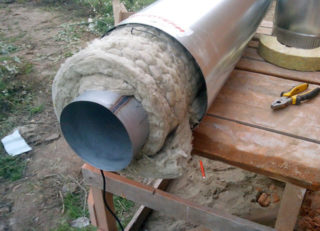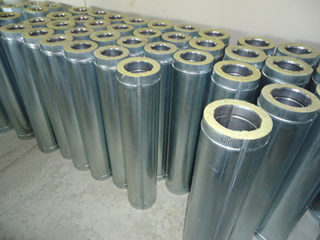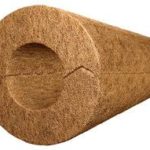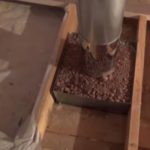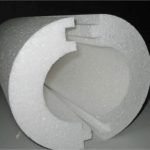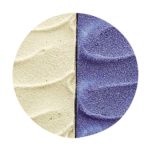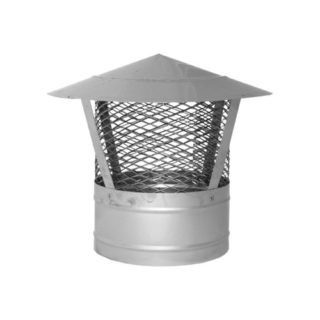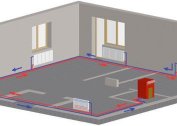The Russian climate is characterized by harsh winters and cold off-season periods. This involves the arrangement of private houses, cottages, cottages and baths with autonomous heating systems. An integral part of these structures are structures designed to divert combustion products of fuel. The efficiency of the boiler and the safety of the entire building depend on properly executed insulation of the chimney pipe. You can do this task with your own hands, saving on the services of professionals. It is only necessary to choose the right insulation for chimneys and the most suitable technology for its installation.
Prerequisites for the destruction of the chimney
Pipe combustion products are subjected to extreme tests related to exposure to chemically active substances, changes in temperature and humidity.
In the absence of high-quality thermal insulation, the chimney quickly collapses under the influence of the following factors:
- Combustion of fuel is accompanied by a large amount of heat, which affects the walls of the outlet pipe. If they are not protected by insulation, condensation will form on the inner surface. Moisture is absorbed into the brick and joints, when freezing expands and breaks the masonry.
- Creosote settling on pipes dissolves with water and turns into a chemically active substance, with an increased level of acidity. The solution causes corrosion of the metal and can corrode it through in just one season. Such a corrosive substance can not resist even stainless steel.
- A dense oily coating gradually accumulates on the walls of the pipe, gradually overlapping its section, until it is completely closed. Lack of traction is fraught with poisoning of residents with carbon monoxide.
- A gas outlet passing through the roof heats the roof and rafters. There is a high probability of a fire, especially when deposits accumulate in the pipe break out.
The use of modern insulation for chimneys minimizes the risk of fire and ensures a more efficient operation of the heating system.
Positive aspects of chimney insulation
If you insulate a chimney metal pipe with your own hands, you can for many years forget about its cleaning, replacement and even maintenance. High-quality design works clearly and without any complications.
The pipe insulated for the chimney has the following advantages:
- No moisture is formed in the channel. Due to this, chemically active elements do not linger on its walls, but fly out into the street or settle in the filter (on the visor).
- The inner surface of the pipes remains clean and smooth. Traction is always good and stable. There is no need to carry out a time-consuming and accompanied by the release of a large amount of dust channel cleaning.
- Insulation for the chimney blocks the heat passing through it. The outer walls remain cold, which helps to preserve the integrity of the roofing material, eliminates the risk of fire.
- Increase furnace energy efficiency. Energy is not expended on evaporation of moisture and burning of deposits. Fuel consumption is reduced regardless of whether gas, firewood or coal is used.
- Providing additional trunk stability. Thermal insulation for chimney pipes serves as an additional frame, protecting the channel from wind loads.
Do-it-yourself insulation of the chimney involves the application of certain efforts, the cost of effort and money. However, this is a profitable investment that will pay off in the shortest time in terms of finances, increasing the level of comfort and safety of living in the house.
Materials for insulation
The choice of material for the insulation of the chimney should be approached carefully, paying attention to any trifle. Construction is designed for a long operating time, it is necessary to take into account all the nuances during planning and installation.
The insulation must meet the following requirements:
- incombustible;
- thin;
- heat resistant;
- moisture resistant
- durable
- biologically inert;
- easy to use;
- easy;
- preserving shape and volume;
- environmentally friendly.
The necessary materials are available in the form of plates and mats, roll, sheet and loose form.
The best technology for chimney insulation is considered to be a heat-insulating steel cylinder filled with insulating material. The product is two iron pipes connected together with different diameters, where the smaller one serves as a channel for the removal of combustion products, and the upper one is a fence for insulation.
For the manufacture of stainless steel, resistant to high temperatures and mechanical stress. To further reduce thermal conductivity, an asbestos cord is wound on the outside of the casing. The pipeline is connected to the nozzle of the furnace boiler and is brought out to a height of at least 100 cm above the roof.
The following materials can be used as a filler:
- Expanded clay. It is a product of clay vulcanization, is a hollow balls of brown color. To achieve greater density, a mixture of whole and crushed granules is poured into the opening. The filler has low thermal conductivity, but is prone to shrinkage and moisture absorption. High-quality waterproofing of camera joints is required.
- Basalt cotton wool. Stone mineral wool is considered the best heat insulator with a full set of technical characteristics necessary for the construction of furnace systems. The mineral filler is non-combustible, perfectly retains heat, resistant to decay and dampness. The downside is the allocation of small fibers during installation. It must be performed in protective equipment for the skin, organs of vision and breathing.
- Styrofoam. Pipes can be insulated with a material with a combustibility class G2, which withstands heating up to + 600ºС. EPPS brands such as penofol and penoplex fall into this category. The material is fixed to the iron using refractory glue, the cracks are sealed with strip trimmings.
- Penoizol. It is one of the types of polyurethane foam with zero secondary expansion. After cooking, it is poured with the sleeve into the sleeve, where it hardens for 2-3 days. The hardened mass externally resembles polystyrene foam, but surpasses it in insulating qualities and does not decompose when heated.
- Ceramic plaster. The solution can be used for internal filling and for external decoration. The hardened substance has excellent protective properties, is resistant to heat and moisture.
- Basalt wool
- Expanded clay
- Expanded polystyrene
- Ceramic plaster
It is not enough to choose a good insulation, you still need to competently assemble the chimney. To do this, you should familiarize yourself with the nuances of this process.
Subtleties of self-insulation of the chimney
If you plan to use a gas boiler for heating the house, its installation, connection and configuration should be entrusted to specialists. The manufacture of the chimney can be done independently, with a regular set of household tools.
When performing this work, the following nuances should be taken into account:
- Thermal insulation must be applied in a continuous and uniform layer. Gaps are heat bridges that cause condensation.
- The joining of double pipes must be carried out so that the lower section enters the socket of the upper product.
- If a membrane sheet is used, it must be fixed so that the inscriptions are on the outside.
- External insulation is carried out after removal and fixation of the channel. Internal insulation is done during the construction process.
- If the roof is laid out with a combustible coating, an arrester must be placed on the top of the chimney.
- It is imperative to install a visor. This low-cost product will protect the canal from dirt, birds, small animals and debris.
- The insulation layer must be thick enough to reliably block furnace heat. For basalt wool you need at least 4 cm, glass and slag - 5 cm, foam fillers - 6 cm, expanded clay - 8 cm.
Properly implemented thermal insulation of the chimney affects the quality removal of combustion products and extends the life of the heating system.

